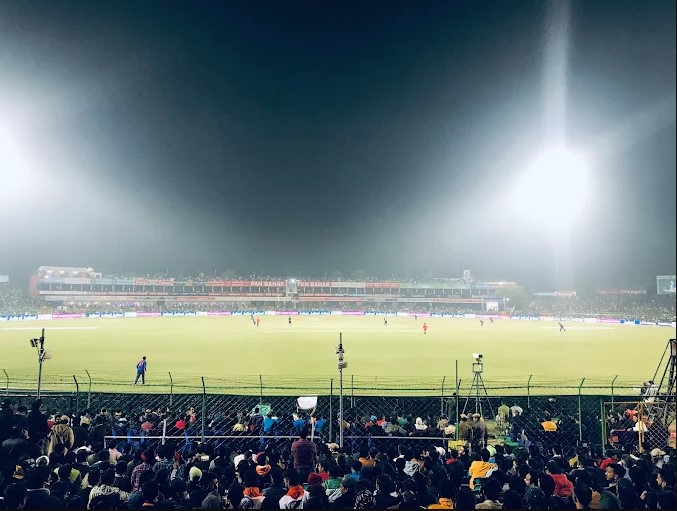Sawai : Cricket stadiums are often celebrated for their iconic architecture, vibrant crowds, and the legends they have hosted. One of India’s most cherished cricketing venues is the Sawai Mansingh Stadium in Jaipur, Rajasthan. While many fans focus on the teams and scores, a lesser-known but crucial aspect of the game is the boundary length—a factor that directly influences scoring patterns, bowler strategies, and field placement.
Table of Contents
Overview of Sawai Mansingh Stadium
| Feature | Details |
|---|---|
| Location | Jaipur, Rajasthan, India |
| Established | 1969 |
| Seating Capacity | Approx. 30,000 |
| Owned by | Rajasthan Cricket Association |
| Named after | Maharaja Sawai Man Singh II |
| First International Match | 1983 (India vs Pakistan, ODI) |
| IPL Home Ground | Rajasthan Royals |
Boundary Length Details
The boundary length in a cricket ground refers to the distance from the center of the pitch to the boundary rope, which defines the field of play. The International Cricket Council (ICC) does not enforce a uniform boundary length, but recommends a minimum of 65 meters and a maximum of 85 meters from the center of the pitch.
At Sawai Mansingh Stadium, the boundary lengths vary slightly based on the pitch strip used and the event setup, but on average:
| Direction | Distance (Approx.) |
|---|---|
| Straight | 75 – 78 meters |
| Square boundaries | 63 – 67 meters |
| Fine leg | 60 – 65 meters |
| Third man | 61 – 66 meters |
| Long-on / Long-off | 73 – 76 meters |
These measurements fall within international standards and are considered moderate—neither too small to encourage mindless hitting nor too large to suppress scoring.
Why Boundary Length Matters
The length of a cricket stadium’s boundary plays a significant role in shaping the outcome of a game. Here’s how:
1. Influence on Batting
- Shorter boundaries typically favor batsmen, especially in T20 matches.
- Players can clear ropes more easily, boosting high-scoring encounters.
- Stadiums like Sawai Mansingh with moderate boundaries provide a fair challenge—stroke play is rewarded, but timing is essential.
2. Impact on Bowling Strategy
- Bowlers have to adapt based on dimensions.
- At SMS Stadium, spinners often come into play because they can use the boundary size to their advantage—baiting batsmen into mistimed shots.
3. Field Placement
- Captains consider boundary size when placing fielders.
- On grounds with asymmetrical boundaries like SMS, fielding setups may vary significantly from one end to another.
How It Compares With Other Indian Stadiums
| Stadium Name | City | Average Straight Boundary | Average Square Boundary |
|---|---|---|---|
| Sawai Mansingh Stadium | Jaipur | 75 – 78 meters | 63 – 67 meters |
| Wankhede Stadium | Mumbai | 70 – 74 meters | 60 – 65 meters |
| Eden Gardens | Kolkata | 76 – 80 meters | 68 – 72 meters |
| M. Chinnaswamy Stadium | Bengaluru | 68 – 72 meters | 60 – 65 meters |
| Narendra Modi Stadium | Ahmedabad | 75 – 80 meters | 70 – 75 meters |
Sawai Mansingh Stadium fits comfortably within the mid-size category, making it one of the more balanced venues for both bowlers and batsmen.
Historical Insights: Scores at SMS
Let’s look at some score trends in limited-overs formats that reflect how boundary length and pitch behavior have impacted match outcomes:
ODI Matches
| Match | Year | Total Score (1st Innings) | Outcome |
|---|---|---|---|
| India vs Pakistan | 1983 | 176/9 | India lost |
| India vs England | 2006 | 288/5 | India won |
| India vs Australia | 2007 | 292/8 | India lost |
T20 Matches (IPL & International)
| Match | Year | Team Score | Match Result |
|---|---|---|---|
| RR vs KKR | 2023 | 202/5 | RR won |
| RR vs MI | 2022 | 174/8 | MI won |
| India vs NZ | 2021 | 166/5 | India won |
From these figures, it’s clear that moderate boundary lengths allow for competitive totals but don’t skew the game entirely toward big hitting.
Stadium Design and Boundary Variability
Sawai Mansingh Stadium is an elliptical ground, which means the distance to the boundary varies with angles. Here are a few unique aspects:
- Longer Straight Boundaries: Encourages bowlers to pitch full deliveries and challenge batsmen to go aerial.
- Slightly Short Square Boundaries: Invites risk-taking, often leading to crowd-thrilling sixes.
- Symmetrical Layout (from side to side): Fielding captains can deploy mirrored setups.
Global Context: Compared to International Venues
| Stadium | Country | Average Boundary Length |
|---|---|---|
| MCG (Melbourne) | Australia | 83 – 87 meters |
| Lord’s | England | 75 – 80 meters |
| Newlands | South Africa | 70 – 74 meters |
| Eden Park | New Zealand | 55 – 60 meters (shortest) |
| Sawai Mansingh Stadium | India | 63 – 78 meters |
While some grounds like Eden Park have unusually short boundaries, the Sawai Mansingh Stadium provides a more traditional cricketing experience.
Sawai Mansingh Stadium, with its balanced boundary dimensions, is an ideal venue for all formats of cricket. The boundary length:
- Promotes strategic depth in T20s and ODIs.
- Provides equal opportunity to spinners and pacers.
- Encourages classical stroke play over mere power hitting.
Its mid-sized boundaries contribute to the unpredictability of matches—neither extreme favor to batsmen nor undue advantage to bowlers. Combined with its rich history and passionate local crowd, SMS remains one of India’s most beloved cricketing venues.


